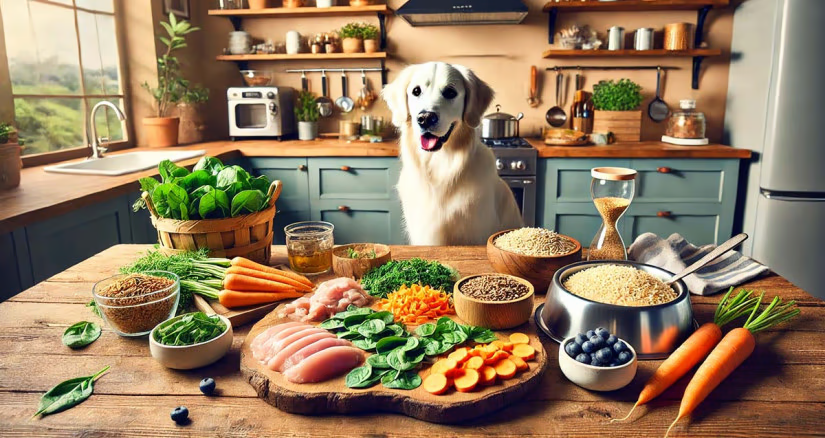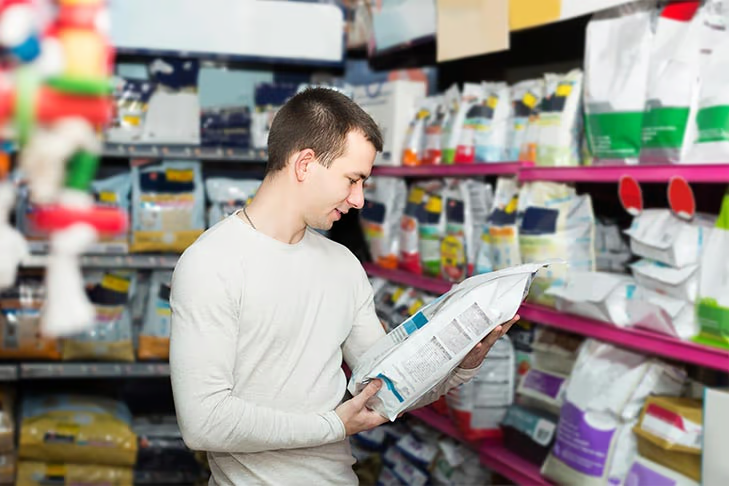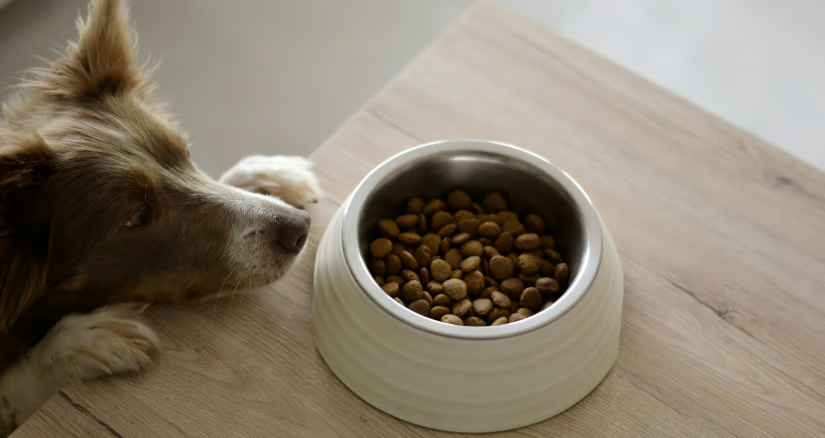This trend, like many others, is making its way into the pet food industry and driving consumers to adopt more process controlled feeding regimens for their pets such as home-cooked meals.2
Home-cooked foods may serve many benefits for the pet but also require careful planning and consideration to ensure meals are nutritionally balanced and safe.
What constitutes a balanced diet?
Many home-cooked pet food recipes available online are unbalanced and do not provide adequate nutrition for the pet.3 A balanced diet must include the appropriate proportions of all nutrients: proteins, fats, carbohydrates, and vitamins and minerals, for a specific life stage and species. Similar to humans, the nutritional requirements for dogs and cats are quite specific and vary based on factors such as age, weight, spayed/neutered, and current health conditions. It is essential to seek advice from well-educated, credentialed individuals (such as a veterinary nutritionists or veterinary technician nutritionist) on these requirements to ensure adequate nutrition when preparing home-cooked pet diets.
Protein – Protein provides amino acids that dogs and cats need to maintain muscle mass and essential body functions. An essential amino acid cannot be synthesized and therefore are required in the diet and are required for maintenance, growth, gestation, and lactation. 4 Non-essential amino acids can be synthesized in the body from other amino acids and co-factors and may not necessarily be needed to be supplied through diet alone. According to AAFCO, the minimum protein requirement for dogs is 18.00% on a 100% dry matter basis (DMB) for adult dogs and 22.50% to support growth and reproduction. The minimum protein requirement for cats is 26.00% on a 100% DMB for adult cats and 30.00% to support growth and reproduction.5
Fat – Dietary fats are a source of concentrated energy for storage and utilization in the body and supply fatty acids that dogs and cats cannot synthesize (essential fatty acids).4 While some fat sources have been labeled as 'good' or 'unhealthy' it is important to select fats in a homemade diet that bring in an appropriate amount of fatty acids. Therefore, while some dietary fat sources sound better, they may not be the most ideal for the pet's requirements. According to AAFCO, the minimum fat requirement for dogs is 5.50% on a 100% DMB for adult dogs and 8.50% to support growth and reproduction. The minimum protein requirement for cats is 9.00% on a 100% DMB for adult cats and 9.00% to support growth and reproduction.5
Carbohydrates – Carbohydrates provide a good source of energy and dietary fiber for animals and are the primary energy source for omnivorous animals.4 Even though there is not a carbohydrate minimum requirement for cats and dogs according to AAFCO, it is important to note that glucose is the brain's preferred source of energy, which comes from the breakdown of carbohydrates. Additionally, carbohydrates, like fruits and vegetables, may also add notable amounts of vitamins and minerals to the diet.
Vitamins and Minerals – Adequate and balanced amounts of vitamins and minerals are essential to support normal physiological and metabolic functioning in animals.4 Vitamins and minerals are often supplemented in pet diets to ensure nutritional adequacy.
Advantages of home cooked meals
Customization – Home-cooking meals for a pet allows for customization specifically for a pet who has specific dietary needs or has food intolerances.
Control – Home-cooking meals for a pet allows the owner a greater control over what ingredients go into the meal, as well as what ingredients are not included. However, 'diet drift' can be just as dangerous as the benefits of knowing what all is in a pet's diet. Diet drift is a term used to describe the shifts over time to a pet's homemade diet that can lead to nutrient imbalances.
Bonding – Preparing a pet's meal can provide a sense of bonding between the pet and their owner.
Potential risks and how to mitigate them
Nutritional Imbalances – One of the most significant risks associated with homemade pet foods is having a diet that is not complete and balanced. As stated above, a balanced, home-cooked diet includes adequate levels of protein, fat, amino acids, fatty acids, vitamins, and minerals according to AAFCO for the animal, which is vital to follow to ensure proper nutrition for the animal's optimal health. Providing an appropriate balance of these requirements may be difficult to navigate for the average consumer, so one may consider consulting with a veterinary nutritionist or a veterinary technician who specializes in nutrition to help design a diet that meets all the necessary nutritional requirements for a pet. Unless the diet is sent off to a third-party laboratory for testing, it is truly unknown if the diet meets all nutrient requirements.
Food Safety – When cooking at home for a pet, safe food handling and proper cooking techniques are critical to prevent the potential for foodborne illness. Not only are foodborne pathogens dangerous for the animal, but they will cause serious illness in the owner as well. Like checking nutrients, diets can be sent to third-party laboratories to test for microbes that may be present in the food. Similar to human food, the FDA has established a zero-tolerance policy on levels of Salmonella bacteria in pet food.6
Time and Cost – While the potential for bonding is present, home-cooking meals for a pet can be time-consuming and often more expensive than purchasing a commercial pet diet. One should consider the time, cost, and storage required before beginning to cook for their pet.
Practical tips for starting
Consult Your Veterinarian – Always consult with a Board-Certified Veterinary Nutritionist or a veterinary technician who is specialized in nutrition before changing a pet's diet. These individuals can be located online or through a local veterinarian but will require a consult and review of medical records before any diets are formulated.
Start Slowly – When transitioning a pet to a new diet, start slowly. Gradually introduce new foods into the pet's diet to avoid gastrointestinal upset. This is true for all diet transitions whether commercial or homemade.
Keep Records – When introducing a pet to a new food or diet, it may be helpful to document recipes, ingredients, and the pet's reaction to the new diet. This can be useful for monitoring health over time and can help inform whether changes to a diet would benefit the pet. It is also important to document the recipe in grams to keep log of any variations to minimize diet drift.
Consider Pre-Made Fresh Foods – Preparing home-cooked meals can be a daunting task for any pet owner and is a huge task to take on. Therefore, if pet owners still would like to have a gently cooked option they can consider pre-made fresh, gently cooked meals instead. Many options available on the market also offer customization if the pet has specific dietary needs or preferences.
Conclusion
Home-cooking meals for a pet can be a rewarding way to cater to their dietary needs; however, it requires a significant commitment to ensure nutritional balance and safety. By educating oneself and seeking professional advice, pet owners can provide meals that not only satisfy but also contribute to the health and well-being of their pet. Whether planning to supplement with home-cooked meals or fully committing to them, it is important to remember that these efforts have a direct impact on a pet's health.
Source: BSM Partners
References
- International Food Information Council. 2024 Food & Health Survey. June 20, 2024. https://foodinsight.org/2024-foodhealth-survey/
- Phillips-Donaldson, D. (2024, January 4). 5 more human food trends for pet food to keep top of mind. Pet Food Industry.
- Fell, A. (2013, July 15). Homemade dog food recipes can be risky business, study finds. UC Davis. https://www.ucdavis.edu/news/homemade-dog-food-recipes-can-be-risky-business-study-finds
- National Research Council, Division on Earth, Life Studies, Committee on Animal Nutrition, Subcommittee on Dog, & Cat Nutrition. (2006). Nutrient requirements of dogs and cats. National Academies Press.
- Official Publication; Association of American Feed Control Officials: Champaign, IL, USA, 2024.
- Phillips-Donaldson, D. (2021, May 3). Will zero tolerance for salmonella in pet food ever change?. Pet Food Industry. https://www.petfoodindustry.com/pet-food-market/blog/15467710/will-zero-tolerance-for-salmonella-in-pet-food-ever-change
You could be interested: Think Your Pet Has a Food Allergy? Here's What You Should Know First














